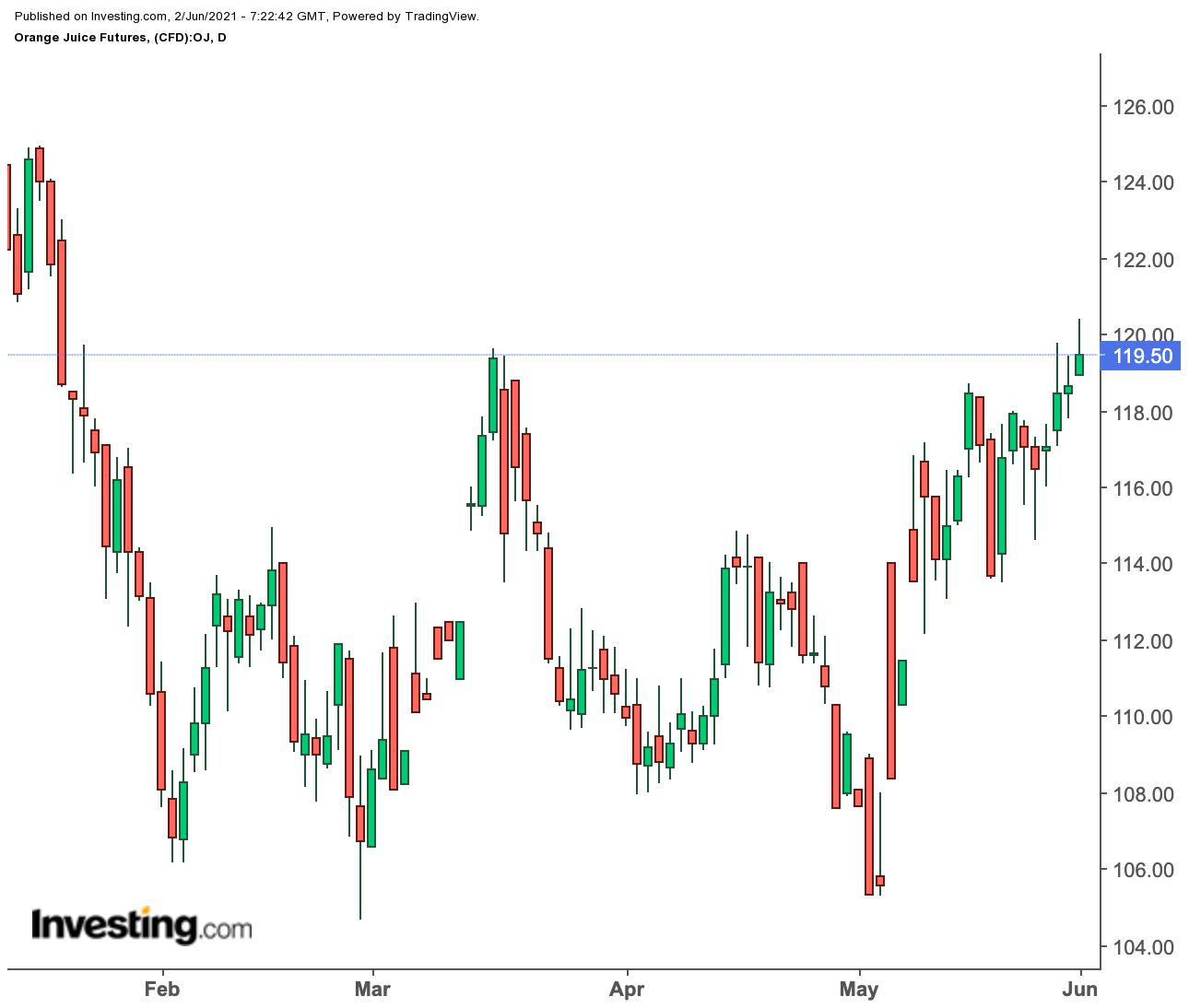Nvidia and TSMC to unveil first domestic wafer for Blackwell chips, Axios reports
After a crushing start to 2021, orange juice has made a sparkling recovery, though not as headline-generating as some of the commodities caught up in this year’s inflation wave. But the approach of summer and the Atlantic Hurricane season are bringing a new boon to those long on the citrus fruit.

As June’s trading began, futures of frozen concentrated orange juice, or FCOJ, vaulted above the key $1.20 per lb level on Tuesday, reaching their loftiest heights in almost five months on concerns over how Atlantic territory storms in the coming weeks would impact Florida, the top orange-growing state.
One of the few commodities that directly prospered in 2020 as a result of the pandemic, orange juice is having mixed fortunes this year as economic reopenings, which mean people spend less time at home, ostensibly reduces focus on—and consumption of—nutritional foods.
Notwithstanding that, orange juice remains an American breakfast staple and chart-wise, Investing.com’s Daily Technical Outlook has a “Strong Buy” recommendation for FCOJ’s front-month July contract.
According to the recommendation, July FCOJ has another upside of $1.2111 after Tuesday’s peak of $1.2040.
But, if the contract reaches below the pivot point of $1.1863, then a succession of downside targets from $1.1781 to $1.1698 and $1.1616 could open up.
After $1.20 High, FCOJ’s Dynamic Range Could Stretch To $1.40
Jack Scoville, who heads all crop research at Chicago brokerage Price Futures Group, has a more dynamic range for the July contract.
In a Tuesday post, he wrote:
“Trends in FCOJ are mixed … with objectives of $1.21, $1.26, and $1.40 July.”
“Support is at $1.17, $1.15, and $1.13, with resistance at $1.20, $1.22, and $1.26 July.”
Scoville said chart trends in FCOJ started to turn up just as the US orange harvest was ending ahead of the official June 20 kick-off of summer.
He added:
“The weather in Florida is good with mostly dry weather. The hurricane season is coming and a big storm could threaten trees and fruit. An active season is anticipated.”
The National Oceanic and Atmospheric Administration (NOAA), a unit of the US Department of Commerce, is predicting an above-normal Atlantic hurricane season in 2021, though not the sort of historic storm activity seen in 2020.
For this year, there could be a likely range of 13 to 20 named storms (winds of 39 mph or higher), of which 6 to 10 could become hurricanes (winds of 74 mph or higher), including 3 to 5 major hurricanes (category 3, 4 or 5; with winds of 111 mph or higher), the NOAA said, predicting with a 70% confidence.
The Atlantic hurricane season extends from June 1 through Nov. 30.
The Florida Movement and Pack report shows that orange inventories in the state were 14% less than last year.
Temperature forecasts, meanwhile, show average to above normal readings.
Aside from the weather impact on Florida, FCOJ futures are influenced by conditions in Brazil and Mexico—two other major citrus growers that export largely to the United States.
Scoville, reporting on the two countries, wrote in his Tuesday blog:
“It is dry in Brazil and crop conditions are called good even with drier than normal soils. Stress to trees could return if the dry weather continues as is in the forecast.”
“Mexican crop conditions in central and southern areas are called good with rains, but earlier dry weather might have hurt production. It is dry in northern and western Mexican growing areas.”
Disclaimer: Barani Krishnan uses a range of views outside his own to bring diversity to his analysis of any market. For neutrality, he sometimes presents contrarian views and market variables. He does not hold a position in the commodities and securities he writes about.
